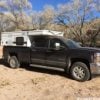
Measured FWC power use
#11

Posted 28 August 2014 - 04:23 AM
What things are you using that consume power?
Is your tv 12 volt and any idea how much power (amps) it uses?
2015 Silverado Crew Cab Duramax and 2015 Front Dinette Grandby
One can change the world, it only requires kindness
http://www.truckcamp...g-family-earth/
#12

Posted 28 August 2014 - 04:54 AM
DJ-still adding up my list of things that use power. i have several lists and what each thing uses but its like, i think the inverter uses more power than all he rest combined, I don't use allot of things-still a back packer at heart, so it's the tv, the vcr, the sat dish when i want to watch the 49ers,, the other things-hot water heater, compressor frig-now that. uses allot of power, i spend allot of times turning it up and down from 4.5 and making sure i don't park the truck with the rear in the sun. It's all new to me, and if i didn't have the cp frig/freezer, i think i got the power to watch when i want too. I really don't use allot of things except when i try to watch a game-a failing on my part-been doing this now for 9 years and learning this new power grid and what works and not - a new learning curve-probably didn't answer your question, but trying-if i didn't want to watch my niners would have more power than i need. ![]() ! just learning
! just learning ![]() 1
1
Smoke
#13

Posted 28 August 2014 - 05:17 AM
It's obviously not the most economical way to go, but it would definetly work.
I was packing a bunch of food for a week long scout camp earlier this summer and had several days of rain and poor sunlight.
Between my ARB and Waeco compressor fridges, I was running out of battery power in a hurry. Just idling my truck for 1-2 hours made all the difference. Next day the sun returned and we were in business.
There are a lot of things that can mess up even a well planned solar and battery system. It's always good to have a back up.
2015 Silverado Crew Cab Duramax and 2015 Front Dinette Grandby
One can change the world, it only requires kindness
http://www.truckcamp...g-family-earth/
#14

Posted 28 August 2014 - 05:43 AM
Thanks-more thinking is needed-and yep i have a Waeco 110 and that thing seems to have a mind of its own-not like my old 3 way frig-more leaning curve and thanks, idling has always been my back up and seems to help now. will i ever reach solar "wonderfulness" ? Down the road maybe another 100 wt panel may be in order, one can always wish all tings will work.
smoke
#15

Posted 28 August 2014 - 03:33 PM
It may put out 30-50 amps as someone said on this thread however the voltage is usually quite low and takes a long time for the batteries to accept the charge.
Really what I'm trying to figure out is how many hours of driving it takes to get to what percentage of charge. This will help those of us with remote, non-permanent solar setups.
Thanks
#16

Posted 28 August 2014 - 03:37 PM
I'm starting to think ski is correct about the the front opening units. Mine does seem to take more energy than I anticipated. I took but didn't use my portable panel this past weekend. No trees in the way but while it seemed to get a good charge in the day I was lower than I expected in the morning. I'm starting to think I should break down and get a meter to see whats really going on. Guessing isn't working so well.
What kind of charge controller do you have and how many volts is it sending to your battery? Also what size solar setup do you have?
If you have enough solar to cover your needs with enough to charge your battery left over, then you may just need to change your charging voltage.
#17

Posted 28 August 2014 - 04:13 PM
I was thinking I want to camp with Smoke to watch the Niners, but preseason has me thinking being cutoff from tv might not be a bad idea.
Craig K6JGV_________________________ 2004 2500 CTD 4X4 FWC HAWK 1960 CJ5
#18

Posted 29 August 2014 - 07:30 AM
DrJ- since you have solar you may not be able to answer but I was wondering if you can provide any numbers on how well your battery bank is charged with just the alternator.
It may put out 30-50 amps as someone said on this thread however the voltage is usually quite low and takes a long time for the batteries to accept the charge.
Really what I'm trying to figure out is how many hours of driving it takes to get to what percentage of charge. This will help those of us with remote, non-permanent solar setups.
Thanks
My understanding of battery charging has always been that it does take a higher voltage like 14.2 or higher to completely charge your battery to 100%.
When you have a fairly discharged battery like 20% or more, it will initially accept a lower voltage and higher amps. But as it approaches 90-95% of capacity it would take a higher voltage to get those last few amp hours back in.
I'm not exactly sure how this works with a truck alternator. But I would suspect it could take a few hours of driving to go from 60% to 90% of charge. Then that last 10% is pretty hard to get in unless your truck alternator runs above 14 volts and the voltage loss isn't too big from your truck to camper. If it only ran 13.5 volts it might never reach 100%. Even at 14.2 volts or more, it would probably take a few hours.
I have the IQ4 smart charger addition to the IOTA in my 2013 Hawk. I've noticed when I'm plugged in to 110 volts it does take several hours to float charge that last 5-10%.
I have to assume our truck charging system would be the same.
I should disconnect the solar, discharge the batteries to 50-60% and then see what happens when I have to drive around. That would be an interesting experiment. But if I had to guess, I bet you could recharge to 85-90% fairly easily and that last 10% would be tough.
2015 Silverado Crew Cab Duramax and 2015 Front Dinette Grandby
One can change the world, it only requires kindness
http://www.truckcamp...g-family-earth/
#19

Posted 29 August 2014 - 03:28 PM
My understanding of battery charging has always been that it does take a higher voltage like 14.2 or higher to completely charge your battery to 100%.
When you have a fairly discharged battery like 20% or more, it will initially accept a lower voltage and higher amps. But as it approaches 90-95% of capacity it would take a higher voltage to get those last few amp hours back in.
I'm not exactly sure how this works with a truck alternator. But I would suspect it could take a few hours of driving to go from 60% to 90% of charge. Then that last 10% is pretty hard to get in unless your truck alternator runs above 14 volts and the voltage loss isn't too big from your truck to camper. If it only ran 13.5 volts it might never reach 100%. Even at 14.2 volts or more, it would probably take a few hours.
I have the IQ4 smart charger addition to the IOTA in my 2013 Hawk. I've noticed when I'm plugged in to 110 volts it does take several hours to float charge that last 5-10%.
I have to assume our truck charging system would be the same.
I should disconnect the solar, discharge the batteries to 50-60% and then see what happens when I have to drive around. That would be an interesting experiment. But if I had to guess, I bet you could recharge to 85-90% fairly easily and that last 10% would be tough.
It would be really interesting! I have read in various places people stating anywhere from 80-100% charge is possible so it would be nice to know for certain. Im also thinking that those of us with the stock FWC wiring that it may be lower than we expect since it is 10 gauge wire and pretty long. I have a pretty significant voltage drop in my current setup and cant even see 13 volts at the aux battery when the truck is running.
#20

Posted 29 August 2014 - 06:03 PM
With only having the built in FWC meter currently I can only present ancillary evidence based on my experience but since I put in my Isotherm 65 a 2-3 hour drive with the fridge running only brings the charge up to 4 lights most of the time. If I drive 5 hours with the fridge running it will bring the batteries to all the way full. Doesn't seem to matter what level the batteries were at when I started.
Hopefully this is all going to change soon as 200W of solar is scheduled to be delivered next week!
Off Road Utility Trailer
Not enough time to go exploring.
0 user(s) are reading this topic
0 members, 0 guests, 0 anonymous users














